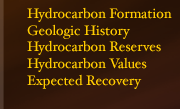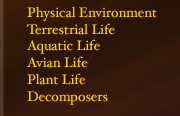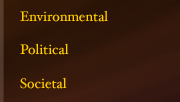
Terrestrial Life - Lemmings and Voles
Lemmings and Voles tend to be more abundant and have less survival issues
than muskoxen. In the winter they live in large underground burrows
that may be as close as two inches from the permafrost. There are two
species of lemmings in the area: the brown lemming (Lemmus sibiricus) and the collared lemming
(Dicrostonyx groenlandicus). The brown lemming
prefers wetter environments like damp meadows and river or lake shores, while
the collared lemming prefers rockier places. Lemmings live on plants,
roots, berries, and lichens, and stored seeds in the winter. (John Whitaker
Jr., 1996)
There are two species of voles in the 1002 area: the northern
red-backed vole (Clethrionomys
rutilus) and the singing vole
(Microtus miurus)
. The northern red-backed vole feeds on leaves, buds, and twigs.
They are active all winter, making the most of their short lives: by the end
of the summer, all those born before the last year have died. The signing
vole is known for its alarm call, a high pitched trill. Singing voles
are colonial, behaving much like prarie dogs. They feed on stored tubers
during the long winter season. Burrows of singing voles are often raided
by native peoples, who pilfer the stored tubers for their own use. (John
Whitaker Jr., 1996)
Because of their numbers lemmings and voles are not likely to be wiped
out by human activity in the region. However, they are an important
source of food for higher lever consumers, including polar bears, wolves,
and foxes. Lemming cycles-- population booms and busts every four to
five years-- for example, are closely tied to the population cycles of various
predators. A sharp drop in their numbers could potentially cause a
population decrease in many other, higher-level consumers. (John Whitaker
Jr., 1996)
Singing Vole (Microtus miurus)
The singing vole is so-named for its high-pitched trill, used to warn members
of its social group. It is a food source for the common avian and mammal
predators of the area. Singing voles dig burrows with ~1" diameter entrances
that may be up to 3' long. This includes a large nest that may be up
to 1' long, and a storage chamber for extra food. Burrows are typically
only 2" from the surface, and are often raided by Native peoples for the
stored tubers.
The singing vole eats lupines, arctic locoweed, horsetail, and sedge.
Its range encompasses Alaska, Yukon, and the Northwest Territories.
It breeds from May to September. Gestation is 21 days. The singing
vole may have up to 3 litters/year, with 4-12 young/litter. (John Whitaker
Jr., 1996)
Northern Red-backed Vole (Clethrionomys rutilus)
Northern Red-backed voles like to eat green herbacious plants and underground
fungi. They store bulbs, stems, tuber, and nuts in their burrows.
Burrow entrances are characterised by pieces of cut vegetation among boulders
and logs. Its range encompasses Alaska and northwest Canada. It
breeds from late May to early September. Gestation is 17-19 days.
Females typically have 2 litters/year, with 4-9/litter. (John Whitaker Jr.,
1996)
Brown Lemming (Lemmus sibiricus)
Brown lemmings live in surface nests made of woven balls of grass 6-8" wide.
They also dig tunnels with chambers 6" diameter. Frequently will a tunnel
or nest be abandoned and a new one created. Brown lemmings feed on
grasses, sedges, and leafty plants during summer. During the winter
months it relies on the bark and twigs of willow and birch. They have
very small home ranges, about 3.5 - 6 sq yds. Lemmings mate typically
from the spring to fall, though sometimes there is breeding throughout winter
as well. There are typically 1-3 litters/yr, with 1-13/litter.
Population fluctuates dramatically, peaking every 3-4 years due to winter
breeding. Then, the lemmings become nervous and hyperactive, and are
prey to the various predators of the area. Brown lemmings inhabit the
wet tundra of Alaska, northern Canada, and northern British Columbia, including
the ANWR region. (John Whitaker Jr., 1996)
Collared Lemming (Dicrostonyx groenlandicus)
Collared lemmings live in surface nests 6-8" wide among rocks and snowdrifts.
They dig tunnel systems with resting chambers as deep as the permafrost line.
During the summer, collared lemmings feed on grasses, sedges, bearberry, and
cotton grass. They also feed on willow twigs and buds year-round.
With a range that spans northern and western Alaska as well as northern Canada,
collared lemmings are a major food source for arctic carnivores including
Arctic foxes, wolves, wolverines, snowy owls, gulls, jaegers, etc.
Collared lemmings breed from March to September. A femal has several
litters a year, with ~7/litter. Gestation is 21 days. (John Whitaker
Jr., 1996)
Impacts of Oil Exploration and Drilling
Lemmings and Voles tend to be more abundant and have less survival issues
than muskoxen. In the winter they live in large underground burrows
that may be as close as two inches from the permafrost. They subsist
on willow twigs, sedges, and stored tubers during the long winter season.
Burrows of voles are often raided by native peoples, who pilfer the stored
tubers for their own use. (John Whitaker Jr., 1996)
Because of their numbers lemmings and voles are not likely to be wiped out
by human activity in the region. However, they are an important source
of food for higher lever consumers, including polar bears, wolves, and foxes.
Lemming cycles, for example, are closely tied to the population cycles of
various predators. A sharp drop in their numbers could potentially cause
a population decrease in many other, higher-level consumers. (John Whitaker
Jr., 1996)





